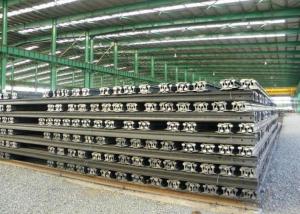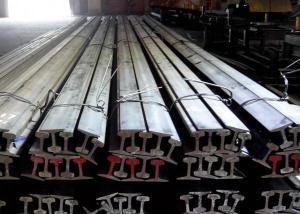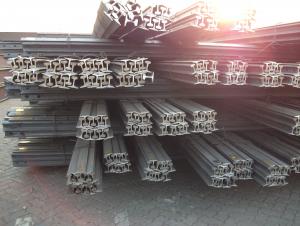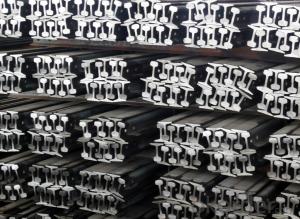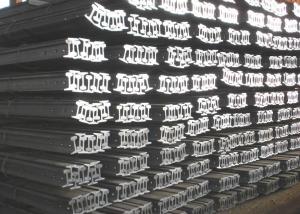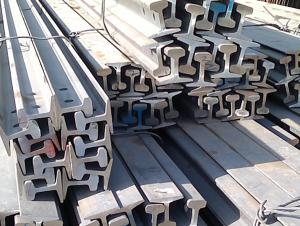MS Steel Rail GB Standard with High Quality for Sale
- Loading Port:
- China main port
- Payment Terms:
- TT or LC
- Min Order Qty:
- 25 m.t.
- Supply Capability:
- 100000 m.t./month
OKorder Service Pledge
OKorder Financial Service
You Might Also Like
Product Description of MS Steel Rail GB Standard with High Quality for Sale:
Sizes: 38kg, 43kg, 45kg, 50kg, 60kg.
Production Standard: GB2585-81, DIN, AREMA, JIS, BS, UIC, etc.
Material: 50MN, U71MN, 900A, 110A, etc.
Length: 6m-25m according to the requriements of the clients
Usages of MS Steel Rail GB Standard with High Quality for Sale:
Light rail is mainly used in forest region, mines, factories and construction sites laid of the place such as temporary transport line and light motorcycles with line. Be widely used for railway, subway, transportation track, express, curve way, tunnel way and so on.
Packaging & Delivery of MS Steel Rail GB Standard with High Quality for Sale:
1. Packing: it is nude packed in bundles by steel wire rod
2. Bundle weight: not more than 3.5MT for bulk vessel; less than 3 MT for container load
3. Marks:
Color marking: There will be color marking on both end of the bundle for the cargo delivered by bulk vessel. That makes it easily to distinguish at the destination port.
Tag mark: there will be tag mark tied up on the bundles. The information usually including supplier logo and name, product name, made in China, shipping marks and other information request by the customer.
If loading by container the marking is not needed, but we will prepare it as customer request.
4. Transportation: the goods are delivered by truck from mill to loading port, the maximum quantity can be loaded is around 40MTs by each truck. If the order quantity cannot reach the full truck loaded, the transportation cost per ton will be little higher than full load.
5. Delivered by container or bulk vessel
6. Delivery Time: All the Hot Rolled Steel Rail will be transpoted at the port of Tianjin, China within 30 days after receiving the advance payment by T/T or the orginal L/C at sight.
Inspection of MS Steel Rail GB Standard with High Quality for Sale:
We will send the MTC of the factory to the clients dirrectly which contain the anlisis of the heat, chemiqul composition, phisical characteristicas, etc.
And our inspectors will arrive at the factory to meke the inspection of the size, length, weight and quantity before the transportation from the factory.
FAQ:
Q1: Why buy Materials & Equipment from OKorder.com?
A1: All products offered by OKorder.com are carefully selected from China's most reliable manufacturing enterprises. Through its ISO certifications, OKorder.com adheres to the highest standards and a commitment to supply chain safety and customer satisfaction.
Q2: What makes stainless steel stainless?
A2: Stainless steel must contain at least 10.5 % chromium. It is this element that reacts with the oxygen in the air to form a complex chrome-oxide surface layer that is invisible but strong enough to prevent further oxygen from "staining" (rusting) the surface. Higher levels of chromium and the addition of other alloying elements such as nickel and molybdenum enhance this surface layer and improve the corrosion resistance of the stainless material.
Q3: Can stainless steel rust?
A3: Stainless does not "rust" as you think of regular steel rusting with a red oxide on the surface that flakes off. If you see red rust it is probably due to some iron particles that have contaminated the surface of the stainless steel and it is these iron particles that are rusting. Look at the source of the rusting and see if you can remove it from the surface.
Images:
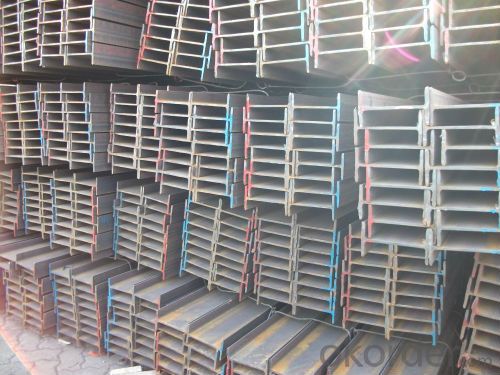

- Q:What are the requirements for steel rail storage and handling?
- The requirements for steel rail storage and handling include proper storage conditions, such as a dry and well-ventilated area to prevent corrosion. Handling should be done with appropriate lifting equipment to avoid damage or distortion to the rails. Additionally, rails should be stored in a way that prevents any bending or twisting, and they should be kept away from moisture, chemicals, and extreme temperatures.
- Q:What are the factors considered in determining the appropriate steel rail length for a railway line?
- The factors considered in determining the appropriate steel rail length for a railway line include the expected train speed, the weight and type of trains that will be using the line, the curvature and gradient of the track, the expected traffic volume, and the available space for the rail installation.
- Q:What are the different types of steel rail profiles?
- There are several different types of steel rail profiles, including the commonly used flat-bottomed rail, the inverted U-shaped rail, the bulbous rail, and the Vignoles rail. Each profile has specific characteristics and is used for different applications in the railway industry.
- Q:Can steel rails be used for automated or driverless train systems?
- Automated or driverless train systems can utilize steel rails effectively. Steel rails have been the preferred option for train tracks for many years due to their durability, strength, and reliability. By using steel rails, trains can move smoothly and efficiently, reducing friction and enabling high speeds. To operate without human intervention, automated or driverless train systems rely on advanced technologies like sensors, artificial intelligence, and computer systems. These systems can easily be integrated with steel rail tracks to guide and control the trains. Steel rails offer a well-defined path for automated train systems, allowing for precise and accurate navigation. The tracks are designed to ensure stability and safety, which is crucial for the proper functioning of driverless trains. Moreover, steel rails can handle heavy loads and provide excellent traction, ensuring smooth acceleration and braking. Furthermore, steel rails have a long lifespan and require minimal maintenance, making them cost-effective for automated train systems. Regular inspections and maintenance can ensure that the tracks remain in good condition, preventing any potential issues that could affect the operations of the automated trains. In conclusion, steel rails are a reliable and suitable choice for automated or driverless train systems. They provide the necessary support, stability, and safety for these advanced transportation systems, enabling efficient and seamless movement of trains.
- Q:How are steel rails used in high-speed railways?
- High-speed railways heavily rely on steel rails to guarantee safe and efficient train operations. These rails are specifically crafted and manufactured to endure the immense forces and speeds associated with high-speed trains. One of the main functions of steel rails in high-speed railways is to create a well-leveled and compacted track bed, forming a continuous and rigid track structure. This provides a stable and smooth track for trains to travel on, enabling them to maintain stability and reduce vibrations even at high speeds. Moreover, steel rails contribute to the safety of high-speed railways by serving as a secure and reliable guidance system for trains. The precise fit between the train's wheels and the rails ensures that the train remains on track, even when traveling at high speeds. By guiding the train along its designated path, the rails prevent derailments and accidents. Additionally, the design of steel rails is specifically engineered to withstand the immense forces and loads exerted by high-speed trains. They are made from high-quality steel with specific properties, ensuring durability and longevity. This allows the rails to bear the weight of the train and evenly distribute the load, preventing excessive wear or deformation. Maintenance of steel rails in high-speed railways is crucial to ensure their integrity and safety. Regular inspections and maintenance activities are conducted to identify any potential defects or issues in the rails. This is essential to prevent accidents or disruptions in train services. To summarize, steel rails play a vital role in high-speed railways by providing a stable and smooth track for trains, ensuring safe and efficient operations. They are designed to withstand high speeds and heavy loads, guiding the trains along their intended path while evenly distributing the weight. Regular maintenance and inspections are conducted to ensure the safety and integrity of the steel rails.
- Q:What is the role of steel rails in railway signaling systems?
- The role of steel rails in railway signaling systems is to provide a stable and secure path for trains to travel on. The steel rails act as a guide for the train's wheels, ensuring that it stays on track and follows the designated route. Additionally, the steel rails also play a crucial role in transmitting electrical signals for various signaling systems, such as track circuits, which help detect the presence of trains and control their movements. Overall, steel rails are essential for maintaining safety and efficiency in railway signaling systems.
- Q:How are steel rails affected by ground settlement or shifting?
- Steel rails are affected by ground settlement or shifting in multiple ways. Firstly, if the ground settles or shifts unevenly, it can cause the steel rails to become misaligned, leading to track irregularities and potential derailments. Secondly, ground settlement or shifting can create stress and strain on the rails, which may result in warping or buckling of the tracks. This can further compromise the stability and safety of the rail system. Therefore, ground settlement or shifting poses significant challenges to the integrity and performance of steel rails.
- Q:Can steel rails be reused in track maintenance projects?
- Yes, steel rails can be reused in track maintenance projects. They can be inspected, repaired if necessary, and then put back into service to extend their useful life and reduce costs.
- Q:What is the weight of a standard steel rail?
- The weight of a standard steel rail typically ranges from 115 pounds to 141 pounds per yard.
- Q:How are steel rails protected against ultraviolet (UV) radiation?
- Steel rails are typically protected against ultraviolet (UV) radiation through several methods. One of the most common ways is by applying a specialized coating or paint that contains UV inhibitors. These inhibitors act as a barrier to prevent the UV rays from reaching the surface of the steel rail, thus minimizing the potential damage that can be caused by prolonged exposure to UV radiation. Additionally, some steel rails may undergo a process called galvanization, where a layer of zinc is applied to the surface of the rail. This zinc coating acts as a sacrificial layer, protecting the steel underneath from corrosion and UV radiation. Zinc is known for its excellent resistance to UV radiation, making it an effective protective measure for steel rails. Furthermore, when steel rails are installed in outdoor environments, they are often designed with certain features that help shield them from direct exposure to sunlight. For instance, rail lines are strategically placed to minimize the amount of sunlight that directly falls on the rails. Additionally, vegetation or other forms of shade may be used to provide further protection against UV radiation. It is important to note that while these protective measures can significantly extend the lifespan of steel rails by preventing damage caused by UV radiation, they are not foolproof. Over time, the protective coatings may degrade or wear off, requiring regular inspections and maintenance to ensure continued protection against UV radiation.
1. Manufacturer Overview |
|
|---|---|
| Location | |
| Year Established | |
| Annual Output Value | |
| Main Markets | |
| Company Certifications | |
2. Manufacturer Certificates |
|
|---|---|
| a) Certification Name | |
| Range | |
| Reference | |
| Validity Period | |
3. Manufacturer Capability |
|
|---|---|
| a)Trade Capacity | |
| Nearest Port | |
| Export Percentage | |
| No.of Employees in Trade Department | |
| Language Spoken: | |
| b)Factory Information | |
| Factory Size: | |
| No. of Production Lines | |
| Contract Manufacturing | |
| Product Price Range | |
Send your message to us
MS Steel Rail GB Standard with High Quality for Sale
- Loading Port:
- China main port
- Payment Terms:
- TT or LC
- Min Order Qty:
- 25 m.t.
- Supply Capability:
- 100000 m.t./month
OKorder Service Pledge
OKorder Financial Service
Similar products
New products
Hot products




